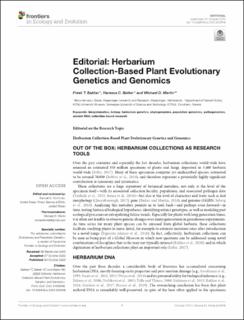| dc.description.abstract | Over the past centuries and especially the last decades, herbarium collections world-wide have amassed an estimated 350 million specimens of plants and fungi, deposited in 3,400 herbaria world-wide (Soltis, 2017). Many of these specimens comprise yet-undescribed species, estimated to be around 70,000 (Bebber et al., 2010), and therefore represent a potentially highly significant contribution to taxonomy and systematics.
These collections are a huge repository of botanical metadata, not only at the level of the specimen itself—with its associated collection locality, population, and associated pathogen data (Yoshida et al., 2015; James et al., 2018)—but also at the level of characters and traits such as leaf morphology (Queenborough, 2017), gene (Bieker and Martin, 2018), and genome (GGBN; Seberg et al., 2016). Analyzing this metadata permits us to look back—and perhaps even forward—in time, testing historical biological hypotheses, identifying extinct genotypes, as well as modeling past ecological processes or extrapolating future trends. Especially for plants with long generation times, it is often not feasible to observe genetic changes over many generations in greenhouse experiments. As time series for many plant species can be amassed from global herbaria, these collections facilitate studying plants in more detail, for example to estimate mutation rates after introduction to a novel range (Exposito-Alonso et al., 2018). In fact, collectively, herbarium collections can be seen as being part of a Global Museum in which new questions can be addressed using novel combinations of disciplines that so far may not typically interact (Bakker et al., 2020), and in which digitisation of herbarium collections plays an important role (Soltis, 2017). | en_US |
| dc.description.localcode | Copyright © 2020 Bakker, Bieker and Martin. This is an open-access article distributed under the terms of the Creative Commons Attribution License (CC BY). The use, distribution or reproduction in other forums is permitted, provided the original author(s) and the copyright owner(s) are credited and that the original publication in this journal is cited, in accordance with accepted academic practice. No use, distribution or reproduction is permitted which does not comply with these terms. | en_US |

